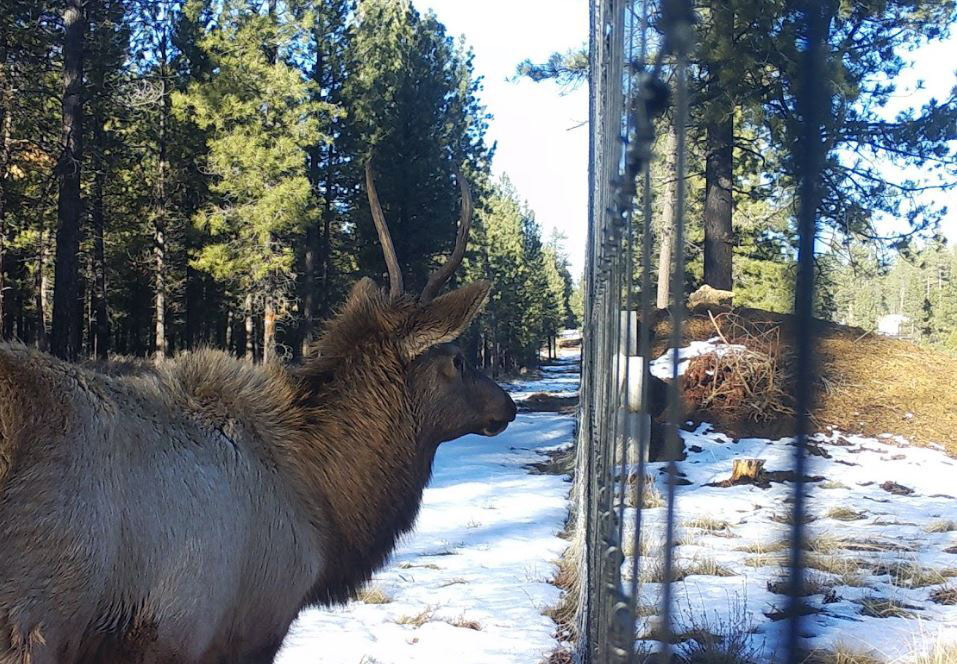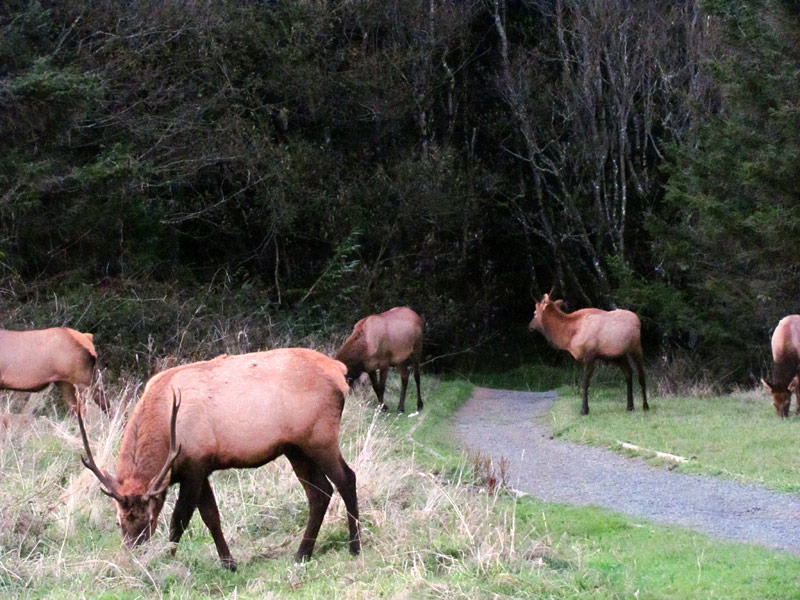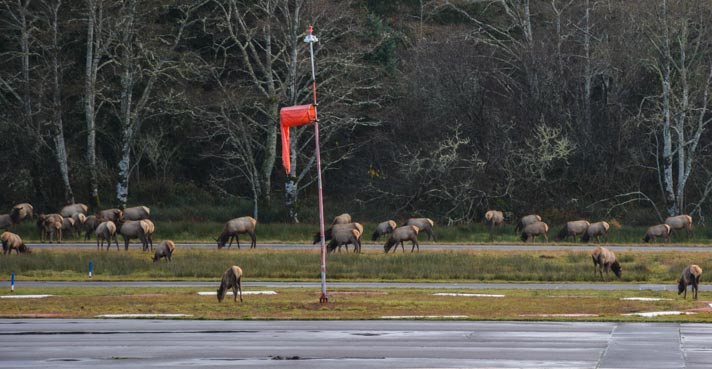Wildlife Road Collisions Jump This Time of Year - How to Avoid Them | Oregon Coast Beach Connection
Published 10/30/23 at 7:33 p.m.
By Oregon Coast Beach Connection staff

(Seaside, Oregon) – Now is the time of year when run-ins with large beasties on the roads around Oregon become a little more frequent – namely vehicular collisions with them. Oregon Department of Fish and Wildlife (ODFW) is getting out the message that deer and elk are in their peak migration season in October and November, making them more likely to roam across the roads and get hit by motorists. (Above: elk at Cannon Beach's Ecola State Park / Oregon Coast Beach Connection)
Includes exclusive listings; some specials in winter
In Cannon Beach:
Includes rentals not listed anywhere else
In Manzanita, Wheeler, Rockaway Beach:
Some specials for winter
In Pacific City, Oceanside:
Some specials for winter
In Lincoln City:
Some specials for winter
In Depoe Bay, Gleneden Beach:
Some specials for winter
In Newport:
Look for some specials
In Waldport
Some specials for winter
In Yachats, Florence
Some specials for winter
Southern Oregon Coast Hotels / Lodgings
Reedsport to Brookings, places to stay; winter deals
It happens all over wilderness and rural areas of the state, including the Oregon Coast Range and Highway 101 along the coastline, as that's where Roosevelt Elk make their home.
Also see Cautions, Advice for Watching Elk on Oregon Coast
ODFW said less daylight hours and an increase in rainy weather begin to reduce visibility for drivers. In most years, Oregon Department of Transportation (ODOT) ends up removing some 6,000 carcasses of deer alone that were struck by vehicles. Scores of others die on roads maintained by other districts.
Sadly, these migratory behaviors are deeply ingrained in many species.
“[ODFW] research with GPS-collars shows mule deer faithfully follow their migratory route, no matter how many roads or other obstacles get put in the way,” ODFW said. “They often have no choice but to cross roads to get to food and shelter.”
Along the north Oregon coast, Roosevelt elk are often seen in areas between Seaside and Cannon Beach lounging on the hills overlooking the highway, where they cause traffic to stop just so drivers can get a good picture. However, in the Coast Range and just north of Seaside, that's where the collision issues really come into play.
ODFW is urging drivers to be on the alert for wildlife crossing public roadways and highways such as these.
How can you avoid hitting one of these creatures?
ODFW said there are known animal crossing areas, and these are marked by signs (the yellow signs indicating “elk” or “deer crossing.”) Be alert when you see one.
Pay a little more attention in road areas with denser vegetation and / or curves.
“Wildlife near the road may be hard to see,“ ODFW said.
If you see one animal there are likely others. Keep an eye out for more.
When you encounter one near or on the road, slow down and remain in your lane. Swerving is the primary cause of many drivers who loose control and crash.

Courtesy ODFW
“Always wear your seat belt. Even a minor collision could result in serious injuries,” ODFW said.
Two of the highest animal collision hotspots in the state are between Seaside and Warrenton, and just outside of Bandon on the south Oregon coast.
The installation of animal undercrossings in various parts of the state have helped keep them off the roadways. The latest is in NE Oregon near Gilchrist: the first of the crossings to be built and paid for by a combination of various agencies and non-profits.
“Oregon legislature has dedicated funds that support wildlife passage,” ODFW said. “Oregon Hunters Association, Oregon Wildlife Foundation, Oregon Department of Fish and Wildlife and many others have also been key partners in directly supporting wildlife passage projects. Projects like this wouldn’t be possible without support from partners across the state.”
Oregon Coast Hotels in this area - South Coast Hotels - Where to eat - Maps - Virtual Tours
Cannon Beach Lodging
Nehalem Bay Lodgings
Manzanita Hotels, Lodging
Three Capes Lodging
Pacific City Hotels, Lodging
Lincoln City Lodging
Depoe Bay Lodging
Newport Lodging
Waldport Lodging
Yachats Lodging
Oregon Coast Vacation Rentals
Oregon Coast Lodging Specials


More About Oregon Coast hotels, lodging.....
More About Oregon Coast Restaurants, Dining.....
 Andre' GW Hagestedt is editor, owner and primary photographer / videographer of Oregon Coast Beach Connection, an online publication that sees over 1 million pageviews per month. He is also author of several books about the coast.
Andre' GW Hagestedt is editor, owner and primary photographer / videographer of Oregon Coast Beach Connection, an online publication that sees over 1 million pageviews per month. He is also author of several books about the coast.
LATEST Related Oregon Coast Articles
April 25 to 27 at the Clatsop County Fairgrounds. Astoria events, Cannon Beach events
Whale Body Parts Found on Oregon Coast - Two Whales Strand on Washington Coast
One was a rare orca find; both suspected human interaction. Marine sciences
Nehalem State Park Mostly Reopens, Other Oregon Coast Landmarks Follow Soon
Those at Bandon and near Depoe Bay are coming. Travel tips, hotels, camping
Bright and Active Arietids Meteors May Hit Pre-Dawn Hours of Oregon, Washingt...
Look to east hour before sunrise and you may catch a show. Sciences, astronomy, weather
Oregon State Parks Day on June 7: Free Parking and Events on Coast, Inland
Hikes, talks, BBQ, disc golf and even astronomy. Sciences, south coast events, Florence events, Astoria events, Seaside events, Cannon Beach events, Manzanita events, Rockaway Beach events, Tillamook events, Garibaldi events, Oceanside events, Pacific City events, Lincoln City events, Depoe Bay events, Newport events, Waldport events, Newport events, Yachats events, Brookings, Coos Bay, Reedsport
Sizable Price Drop, Deals in Lincoln City During Quiet of April on Central Or...
20 perc off at A1 Vacation Rentals across its roster, including Gleneden Beach. Lincoln City specials
Road Work Coming to North Oregon Coast's Gearhart and One of World's Largest ...
Lane closures this summer on the bridge; major work in Gearhart next year. Washington coast
Oregon's Tillamook Coast Hosts Rigorous Kayaking, Hiking Events in May
Netarts events May 17 and 31; Manzanita events May 14
Back to Oregon Coast
Contact Advertise on Oregon Coast Beach Connection
All Content, unless otherwise attributed, copyright Oregon Coast Beach Connection. Unauthorized use or publication is not permitted





















































